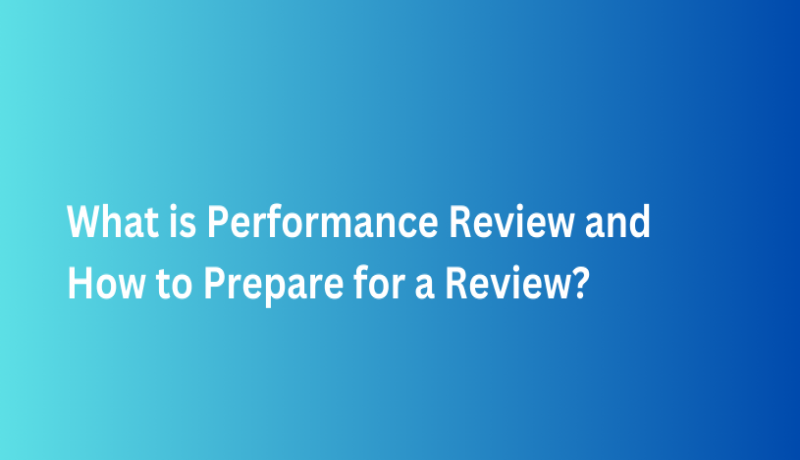What is Performance Review and How to Prepare for a Review?
A performance review, also known as a performance appraisal or evaluation, is a formal assessment of an employee's job performance conducted by a supervisor or manager. The primary purpose of a performance review is to provide feedback on an employee's work over a specific period, typically annually or semi-annually.
It serves several important functions:
1. Feedback and Evaluation
Assessing the employee's performance against predetermined goals and job expectations.
Providing constructive feedback on strengths and areas for improvement.
2. Recognition and Rewards
Acknowledging and rewarding outstanding performance, accomplishments, and contributions.
3. Development and Growth
Identifying opportunities for professional development and career growth.
Discussing training needs and skill development.
4. Goal Setting
Establishing new goals and performance expectations for the upcoming review period.
5. Communication
Facilitating communication between the employee and supervisor, fostering a dialogue about expectations and job satisfaction.
6. Alignment with Organizational Objectives
Ensuring that the employee's work aligns with the organization's goals and values.
The performance review process typically involves several steps:
7. Self-Assessment
Employees may be asked to evaluate their own performance, providing insights into their perspective on achievements and challenges.
8. Manager's Assessment
Supervisors or managers assess the employee's performance based on their observations, feedback from colleagues, and the employee's self-assessment.
9. Feedback Discussion
A meeting is scheduled between the employee and the supervisor to discuss the assessment, address any concerns, and set goals for the future.
10. Goal Setting
New goals and objectives are established for the upcoming review period, and a plan for achieving them may be outlined.
11. Documentation
The outcomes of the performance review, including feedback and goals, are typically documented for reference in future reviews and for HR records.
Here are some tips for a successful performance review:
Prepare in Advance: Both the employee and the supervisor should prepare for the review by gathering relevant information and documentation.
Be Specific: Provide specific examples of the employee's achievements and areas for improvement.
Encourage Two-Way Communication: The review should be a dialogue, allowing the employee to share their perspectives and concerns.
Set Clear Goals: Establish clear, measurable, and achievable goals for the employee to work toward in the next review period.
Follow Up: Regular check-ins throughout the year can help ensure that the employee is on track with their goals and that any issues are addressed promptly.
A well-conducted performance review can contribute to employee satisfaction, motivation, and continuous improvement within an organization.
Preparing for a Performance Review as a Reviewee
As an individual, preparing for a performance review is crucial to ensure a productive and positive discussion with your supervisor.
Here are some steps you can take to prepare effectively:
1. Review Your Goals and Job Description
Look back at the goals you set for yourself during the previous review period. Evaluate your progress and achievements.
Consider how well you've fulfilled your job responsibilities and if there are areas where you've gone above and beyond.
2. Gather Feedback
Seek feedback from colleagues, clients, or anyone you collaborate with regularly. This can provide a well-rounded view of your performance.
Consider both positive feedback and areas where you can improve. Be open to constructive criticism.
3. Document Your Achievements
Make a list of your accomplishments, projects completed, and any positive contributions to the team or organization.
Use specific examples to demonstrate your impact and the value you've added.
4. Identify Challenges
Acknowledge any challenges or areas where you may have faced difficulties. Be prepared to discuss how you addressed or overcame these challenges.
5. Self-Reflection
Reflect on your own strengths and weaknesses. Consider how you've demonstrated key skills required for your role.
Think about areas where you would like to improve and what steps you can take to address those areas.
6. Alignment with Company Values and Objectives
Understand the company's mission, values, and long-term objectives. Assess how your work aligns with these and how you've contributed to the overall success of the organization.
7. Professional Development
Consider your professional development over the review period. Have you attended any training sessions or acquired new skills? Share this information with your supervisor.
8. Prepare for Future Goals
Outline your goals for the upcoming review period. Be specific about what you aim to achieve and how you plan to contribute to the team and organization.
9. Ask for Feedback on Your Preparation
If possible, seek input from a mentor, colleague, or friend. They may provide valuable insights and help you refine your talking points.
10. Be Ready to Discuss Career Growth
If career growth is important to you, be prepared to discuss your aspirations and how you see yourself progressing within the organization.
11. Stay Positive and Open-Minded
Approach the review with a positive mindset. Be open to feedback and demonstrate a willingness to learn and grow.
12. Prepare Questions
Have a few thoughtful questions prepared for your supervisor. This shows that you are engaged and interested in your professional development.
Remember, a performance review is a two-way conversation. It's an opportunity for you to discuss your achievements, receive feedback, and plan for the future. Approach it with a proactive and constructive mindset.








